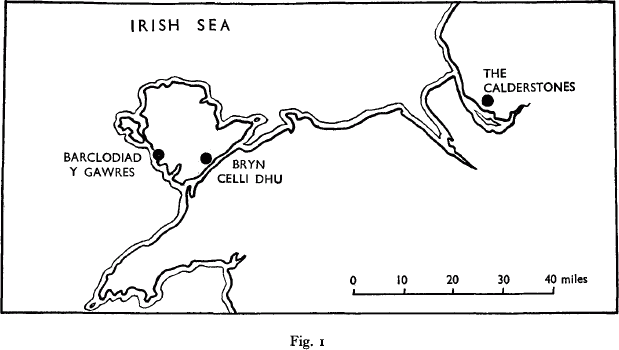Article contents
Megalithic Art in the North-west of Britain: The Calderstones, Liverpool
Published online by Cambridge University Press: 27 May 2014
Extract
The recent discovery of decorated stones in the cruciform Passage Grave of Barclodiad y Gawres, in Anglesey, has made a notable addition to the volume of megalithic mural art known in Britain. The examples of such art described in the present paper increase the number still further. In his discussion of the chamber tombs of England and Wales, Daniel mentions the Calderstones as a possible former burial chamber. At that time (1950), the six Calderstones were arranged in a circle and stood in a small enclosure outside the Menlove Avenue entrance to Calderstones Park, Liverpool (fig. 1). This arrangement was, however, comparatively recent; the original monument was destroyed early in the nineteenth century. The markings were first published in 1864. In 1883, J. R. Allen made measured drawings of the stones, showing the disposition of all the markings known at the time. The same drawings were used by Stewart-Brown in 1911. Allen's drawings recorded only those portions of the stones above ground; examination of the areas then below ground level has revealed a number of new markings.

- Type
- Research Article
- Information
- Copyright
- Copyright © The Prehistoric Society 1958
References
page 20 note 1 Powell, T. G. E. and Daniel, G. E., Excavations at Barclodiad y Gawres, Liverpool University Press, 1956Google Scholar.
page 20 note 2 Daniel, G. E., The Prehistoric Chamber Tombs of England and Wales, CUP, 1950, p. 116Google Scholar.
page 20 note 3 Trans. Hist. Soc. Lancs., Ches., vol. XVII (N. Ser. vol. V), pp. 257–62Google Scholar.
page 21 note 1 Journal of the British Archaeological Association (JBAA), vol. XXXIX, 1883, pp. 304–16Google Scholar.
page 21 note 2 Stewart-Brown, R., A History of the Manor and Township of Allerton, Liverpool, 1911, facing pp. 139 and 140Google Scholar.
page 21 note 3 Piggott, S., Neolithic Cultures of the British Isles, CUP, 1954Google Scholar; Daniel, op. cit., pp. 116 and 183–4.
page 21 note 4 Stewart-Brown, op. cit., pp. 106–7.
page 21 note 5 Baines, E., History, Directory and Gazetteer of the County Palatine of Lancaster, 1825, vol. II, pp. 698–99Google Scholar.
page 21 note 6 The most important information is contained in the issues for November 17th, 20th, 21st and 23rd under the heading ‘What are the Calderstones’? See also Herdman, W. A., A Contribution to the History of the Calderstones, Liverpool, 1896Google Scholar.
page 22 note 1 Museum's Journal, vol. 55, no. 2, May, 1955, pp. 38–9Google Scholar and pl. XIII; vol. 55, No. u, February, 1956, pp. 282–3.
page 24 note 1 Piggott, op. cit., p. 212, and fig. 33.
page 26 note 1 Stewart-Brown, op. cit., facing p. 139.
page 30 note 1 Stewart-Brown, op. cit., pp. 139–40.
page 30 note 2 Stewart-Brown, op. cit., facing p. 139.
page 32 note 1 Raftery, , Prehistoric Ireland, 1951, p. 119Google Scholar, fig. 110.
page 33 note 1 Ríordáin, Ó, Antiquities of the Irish Countryside, 1953Google Scholar, pl. 65.
page 33 note 2 Piggott, op. cit., p. 214, Table V.
page 34 note 1 Ó Ríordáin, op. cit., pl. 65; Raftery, op. cit., fig. 110.
page 34 note 2 Powell and Daniel, op. cit., pl. 16–18.
page 34 note 3 RCAM (Scotland), Orkney and Shetland, 1946, vol. IIIGoogle Scholar, no. 1246, and pl. 124, fig. 571.
page 34 note 4 Ibid., vol. II, no. 841, and pl. 48, fig. 250.
page 35 note 1 RCAM (Scotland), Orkney and Shetland, 1946, vol. IIIGoogle Scholar, no. 1752.
page 35 note 2 PSAS, vol. XIII, 1878–1879, p. 31Google Scholar (fig.)
page 35 note 3 JBAA, vol. XXXIX, p. 308Google Scholar; PSAS., vol. XIII, p. 38Google Scholar.
page 35 note 4 Ibid., p. 312; PSAS, XIII, p. 42Google Scholar; PRIA, X, p. 441Google Scholar.
page 35 note 5 But, see pp. 231–2 of the present volume for a description by Mr L. V. Grinsell of a number recently found by him on the covering slab of a stone cist in Mendip.
page 35 note 5 JBAA, XXXIX, p. 308Google Scholar.
page 36 note 1 Stewart-Brown, op. cit., pp. 106–7.
page 37 note 1 Reallexikon, III, 212 ff.Google Scholar; Almgren, , Hallristningar och Kultbrok (Stockholm, 1927)Google Scholar; Brøndsted, , Danmarks Oldtid, II, 133Google Scholar, fig. 120 (distribution map), 134, fig. 121; Althin, , Felszeichnungen von Skane (Lund, 1945), p. 143Google Scholar, fig. 76 (distribution map), pis. 48, 50, 52, 54 and 55; Fett, E. and Fett, P., Sydvestnorske Helleristninger (Stavanger, 1941)Google Scholar.
page 37 note 2 Schwantes, , Altschlesien, V, 351Google Scholar (Seger Festschrift), Geschichte Schleswig-Holsteins, Bd. I, 266Google Scholar; Sprockhoff, Die Nordische Megalithkultur, pl. 66.
page 37 note 3 Corpus des Signes Gravés, pls. 75–8, 136.
page 37 note 4 Bicknell, , Guide to the Prehistoric Rock Engravings in the Italian Maritime Alps (Bordighera, 1913), p. 89Google Scholar, and pl. XXXII, no. 32.
page 37 note 5 Shetelig, and Falk, , Scandinavian Archaeology (Trans. Gordon, E. V.), Oxford, 1937, p. 160Google Scholar.
page 37 note 6 Bicknell, , Guide to the Prehistoric Rock Engravings in the Italian Maritime Alps (Bordighera, 1913)Google Scholar, pls. XI–XIII.
page 38 note 1 Corpus, pl. 136.
page 38 note 2 Ant. J., XIX, 1939, p. 299Google Scholar.
page 38 note 3 Antiquity, XXVIII, no. 109 (March, 1954), pp. 25–31Google Scholar, pls. I–VIII.
page 38 note 4 Ríordáin, Ó, Archaeologia, LXXXVI (2nd Ser., XXXVI), 1937, pp. 299–301Google Scholar.
page 38 note 5 Ó Ríordáin, op. cit., figs. 48 (No. 86), 49 (No. 88) and 51 (No. 121).
page 39 note 1 Piggott, op. cit., p. 212, and fig. 33, 4a and 4b.
- 5
- Cited by




